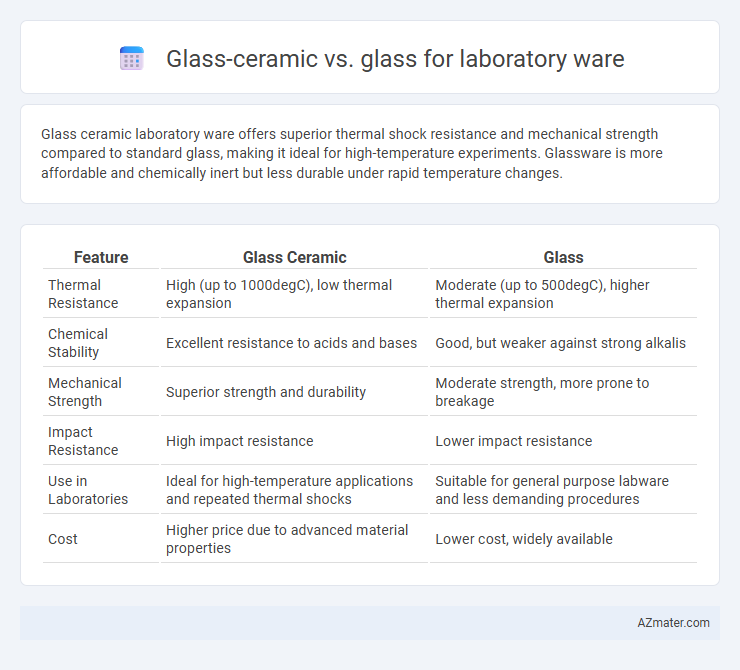Glass ceramic laboratory ware offers superior thermal shock resistance and mechanical strength compared to standard glass, making it ideal for high-temperature experiments. Glassware is more affordable and chemically inert but less durable under rapid temperature changes.
Table of Comparison
| Feature | Glass Ceramic | Glass |
|---|---|---|
| Thermal Resistance | High (up to 1000degC), low thermal expansion | Moderate (up to 500degC), higher thermal expansion |
| Chemical Stability | Excellent resistance to acids and bases | Good, but weaker against strong alkalis |
| Mechanical Strength | Superior strength and durability | Moderate strength, more prone to breakage |
| Impact Resistance | High impact resistance | Lower impact resistance |
| Use in Laboratories | Ideal for high-temperature applications and repeated thermal shocks | Suitable for general purpose labware and less demanding procedures |
| Cost | Higher price due to advanced material properties | Lower cost, widely available |
Introduction to Laboratory Ware Materials
Glass ceramic laboratory ware offers superior thermal shock resistance and mechanical strength compared to traditional glass, making it ideal for high-temperature experiments and rapid temperature changes. Borosilicate glass, a common laboratory glass, provides good chemical durability and moderate thermal resistance but is more prone to breakage under sudden thermal stress. Selecting between glass ceramic and glass depends on the specific laboratory application's need for durability, thermal stability, and chemical resistance.
Overview of Glass Ceramics
Glass ceramics for laboratory ware exhibit superior thermal shock resistance, chemical durability, and mechanical strength compared to conventional glass. These materials are engineered through controlled crystallization, resulting in a microstructure that combines the transparency of glass with the robustness of ceramics. Their enhanced performance makes glass ceramics ideal for high-temperature reactions and precise scientific applications.
Properties of Traditional Glass
Traditional glass used in laboratory ware, such as soda-lime glass, offers moderate thermal resistance and chemical durability but is prone to thermal shock and limited acid resistance. Its brittleness and lower resistance to sudden temperature changes make it less suitable for high-temperature experiments compared to glass ceramic, which combines glass and crystalline properties for enhanced strength and thermal stability. Despite its affordability and ease of fabrication, traditional glass requires careful handling and is often replaced by borosilicate or glass ceramic materials in demanding laboratory applications.
Chemical Resistance: Glass Ceramic vs Glass
Glass ceramic laboratory ware exhibits superior chemical resistance compared to traditional glass, effectively withstanding strong acids, alkalis, and solvents without degradation. The crystalline structure of glass ceramics enhances durability and minimizes leaching, making them ideal for handling aggressive chemicals in laboratory settings. In contrast, standard glass is more susceptible to etching and corrosion when exposed to harsh chemicals, limiting its lifespan and reliability in demanding experiments.
Thermal Stability and Shock Resistance
Glass ceramic laboratory ware exhibits superior thermal stability, withstanding temperatures up to 1000degC without deformation, compared to typical borosilicate glass that tolerates around 500degC. Its crystalline structure provides exceptional thermal shock resistance, minimizing risk of fracture during rapid temperature changes common in laboratory processes. This makes glass ceramic ideal for high-temperature reactions and applications involving frequent heating and cooling cycles.
Mechanical Strength and Durability
Glass ceramic laboratory ware exhibits superior mechanical strength and durability compared to traditional glass due to its crystalline structure, which enhances resistance to thermal shock and impact. Unlike conventional glass, glass ceramics can withstand rapid temperature changes and mechanical stresses without cracking or breaking, ensuring longer service life in demanding laboratory environments. This makes glass ceramic an ideal choice for applications requiring frequent heating, cooling, and heavy handling.
Applications in Laboratory Settings
Glass ceramic laboratory ware offers superior thermal shock resistance and chemical durability compared to traditional glass, making it ideal for applications involving rapid temperature changes and aggressive reagents. Its enhanced mechanical strength supports precision tasks such as high-temperature reactions, thermal cycling, and microwave heating without risk of fracture. Glass remains widely used for routine mixing, storage, and lower-temperature processes where cost-effectiveness and transparency are prioritized over extreme durability.
Cost Considerations and Availability
Glass ceramic laboratory ware typically costs more than standard glass due to advanced manufacturing processes and superior thermal resistance properties. Availability of glass ceramic is more limited, often requiring specialized suppliers, whereas traditional glass is widely available and produced in larger quantities. Laboratories balancing budget constraints with durability needs may favor standard glass for routine applications and select glass ceramics for high-temperature or thermal shock-sensitive experiments.
Maintenance and Longevity
Glass ceramic laboratory ware offers superior thermal shock resistance and durability compared to traditional glass, significantly reducing the frequency of replacements and repairs. Its non-porous surface prevents chemical absorption, making maintenance simpler by facilitating easier cleaning and sterilization. Due to these properties, glass ceramic labware ensures enhanced longevity and lower overall maintenance costs in demanding laboratory environments.
Choosing the Right Material for Your Lab
Glass ceramic offers superior thermal shock resistance and mechanical strength compared to standard glass, making it ideal for high-temperature laboratory applications. Glass, while more affordable and chemically inert, is prone to cracking under rapid temperature changes, limiting its use in demanding experiments. Selecting glass ceramic ensures durability and safety in procedures involving extreme heat, whereas regular glass remains suitable for routine tasks with moderate thermal exposure.

Infographic: Glass ceramic vs Glass for Laboratory ware
 azmater.com
azmater.com